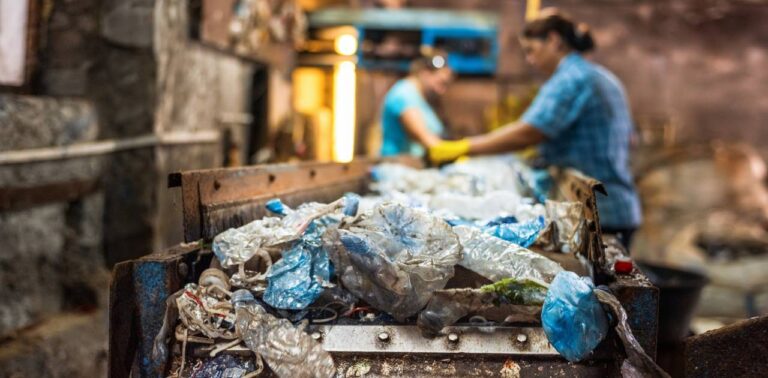Advertisements
Growing concern for the environment has driven the search for alternative materials to replace traditional natural resources. Plastic wood has emerged as a sustainable solution to the consumption of natural wood, offering advantages in terms of both recycling and durability. This material, obtained through the recycling of plastics mixed with other components, such as sawdust and plant fibers, stands out for its diverse applications and the positive impact it has on the environment.

Plastic Wood Manufacturing Process and Composition
It is produced from recycled plastics, which are mixed with wood waste such as sawdust, coconut fibers and other plant materials. This recycling process results in a final product that resembles natural wood, but with superior characteristics in several aspects. The use of recycled plastic in the manufacture of plastic wood not only reduces the amount of plastic waste that ends up in landfills, but also reduces the demand for natural wood, contributing to the preservation of forests.
Benefits for the Environment
One of the biggest benefits is its positive impact on the environment. By using recycled plastics, the manufacturing process of this material helps to mitigate the harmful effects of improper plastic disposal, which is one of the biggest environmental challenges in the modern world. In addition, this wood is resistant to moisture and corrosion, which extends its useful life and reduces the need for frequent replacements, generating less waste over time.
The production of plastic wood also reduces the need for forest exploitation, helping to conserve biodiversity and combat deforestation. In a world where sustainability is becoming increasingly crucial, it offers a viable alternative that combines functionality and environmental responsibility.
Durability and Versatility
Plastic lumber is known for its durability, which surpasses that of natural wood in many applications. Due to its composition, this material is highly resistant to factors that would normally degrade conventional wood, such as humidity, pests, and adverse weather conditions. This resistance makes plastic lumber an ideal choice for exposed areas, such as decks, street furniture, and outdoor structures.
In addition to its durability, it is extremely versatile. It can be manufactured in different shapes and sizes, adapting to a wide range of applications. Its appearance can be as attractive as that of natural wood, with the advantage of not requiring chemical treatments to keep it in good condition. This eliminates the need for pesticides and other harmful chemicals, making plastic wood a healthier option for both the environment and users.
Practical Applications
Plastic lumber is gaining popularity in various areas of construction and design due to its unique properties. In urban spaces, for example, plastic lumber is widely used in park benches, playgrounds and street furniture, where its resistance to vandalism and weathering is highly valued. In coastal areas, its resistance to salt spray makes it a superior choice compared to natural wood, which can deteriorate quickly in such conditions.
In construction, plastic lumber is increasingly being used in structures such as decks, fences and cladding, where durability and low maintenance are crucial. In addition, its ease of handling, allowing it to be sawn, drilled and screwed like regular wood, makes it a practical option for builders and designers looking for sustainable solutions.
Economic and Environmental Benefits
While the initial cost of plastic lumber may be higher than that of conventional lumber, the long-term benefits outweigh this initial investment. The material’s durability and low maintenance reduce repair and replacement costs over time, which is especially advantageous in applications that require high strength, such as public infrastructure and street furniture.
In addition to the economic benefits, the use of plastic lumber promotes responsible environmental practices, aligning with the principles of the circular economy. By reusing plastics that could otherwise contribute to pollution, the production of plastic lumber helps close the life cycle of materials, transforming waste into valuable resources.
Plastic Wood in the Sustainable Future
The future of sustainable construction and design inevitably involves the adoption of alternative materials, and plastic lumber is positioned as one of the most promising. With growing awareness of the importance of recycling and environmental conservation, the demand for plastic lumber is expected to increase, encouraging innovations that make the manufacturing process even more efficient and affordable.
The continued development of recycling technologies will enable plastic lumber to be produced in an even more sustainable way, using a wider range of recyclable materials and further reducing the environmental impact. As the industry evolves, we are likely to see plastic lumber become the norm in applications that were previously dominated by natural wood.
Plastic lumber represents a significant evolution in the use of recycled materials, offering a practical and sustainable alternative to natural wood. Its strength, durability and low environmental impact make it an increasingly popular choice in a variety of applications, from construction to interior design.
Check out other interesting facts about recycling clicking here.
Learn how to make art by recycling, Click here.
Summary




Good idea... But the price is reasonable or more expensive... It's difficult to change habits with the high prices of ecological materials.
Leilaine, it is common to compare plastic wood with the price of conventional wood, but they are different products with different characteristics and production methods.
Conventional wood has a multitude of types, characteristics and many other attributes and is extracted from nature through methods that we are all familiar with, some legal, others not. Plastic wood, on the other hand, is a material that comes from the reuse of plastic and requires a careful manufacturing process to obtain the final product with the cost-benefit that we so advocate, thus becoming a much more advantageous material than conventional wood due to its longevity, even with exposure to sun and rain every day.
Like any product, the price of plastic wood varies according to its quality, finish and use, which can be close to the price of good quality conventional wood. It is necessary to do some price research, but in general it is worth using plastic wood, due to the low maintenance cost and the durability of the material.
I hope I helped 🙂
I would like to know where we can buy recycled material in RS, Vale dos Sinos. I am a fan of recycling.
Ione, see if you can find interested parties in our search area: http://setorreciclagem.com.br/reciclagem-maquinas-equipamentos/
Search for a scrap dealer, recycler or scrap metal dealer, using the name of your city or state.
A hug!